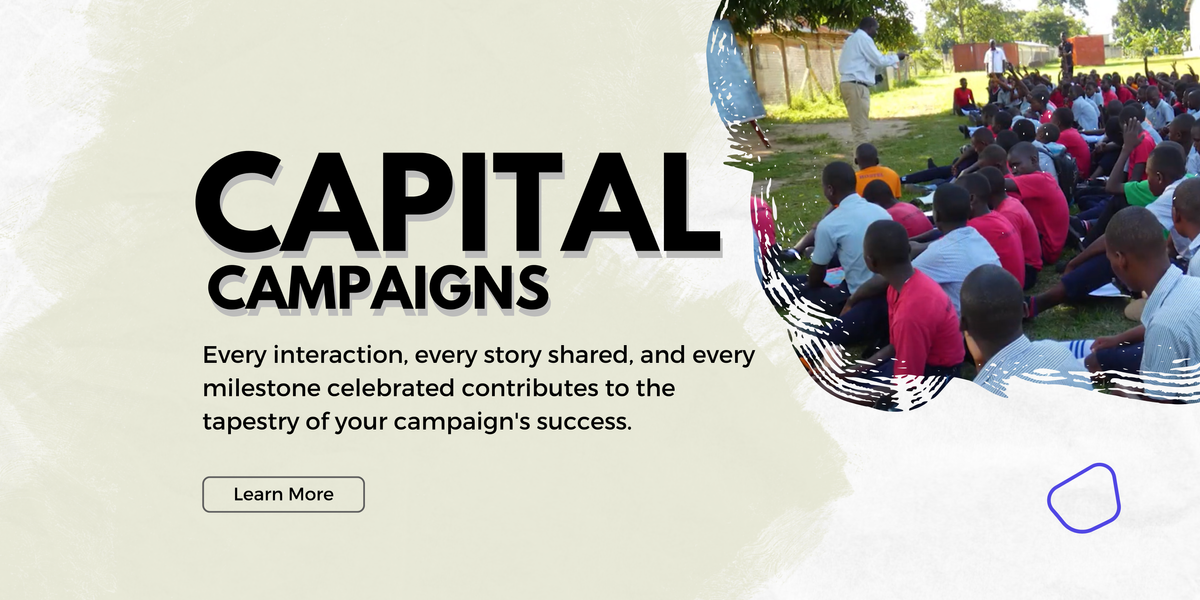Unlocking Capital Campaign Success: Hidden Insights for Nonprofit Fundraising
Learn how to craft a compelling vision, master the art of the ask, and create lasting donor relationships that drive unprecedented success.

1. Crafting a Compelling and Clear Vision
At the heart of every successful capital campaign lies a vision that not only informs but inspires. Your vision is more than a goal—it's the spark that ignites passion in your donors and drives your entire campaign forward.
Clarity is Non-Negotiable
Your vision must be crystal clear, bold, and convey a sense of urgency. Donors need to understand not just what you aim to achieve, but why it's critical to act now.
Refine your case statement relentlessly. Test it with various stakeholders—board members, potential donors, and community leaders—until it's succinct and resonates both emotionally and logically. Don't be afraid to revise and refine; this foundational element sets the tone for your entire campaign.
Storytelling Over Statistics
While data provides credibility, stories create emotional connections. In the world of nonprofit fundraising, emotions often drive decisions.
Incorporate narratives of individuals who will benefit from your project. For instance, if you're raising funds for a new community health center, share the story of a local family struggling to access healthcare. Personal stories can illustrate the real-world impact more effectively than numbers alone.
2. Engaging Lead Donors Strategically
Understanding the dynamics of lead donor engagement can make or break your capital campaign. This is where the art of fundraising truly shines.
The 80/20 Rule in Fundraising
In many campaigns, a small percentage of donors contribute a large portion of the funds. This principle, often called the Pareto Principle, is crucial in capital campaign strategy.
Identify potential lead donors early in your planning process. Research suggests that in some campaigns, as few as 60 households can contribute up to 60% of the goal. Focus your initial efforts on cultivating relationships with these potential major contributors.
Understanding Donor Psychology
Lead donors often think like entrepreneurs—they're comfortable with calculated risks and are attracted to bold visions.
Frame your campaign as an opportunity for significant impact. Highlight the transformative potential of their contribution. For example, show how their donation could be the catalyst that brings a new arts center to life, revitalizing the entire community.
Building Genuine Relationships
In the world of major gifts, trust and personal connections are invaluable.
Invest time in getting to know your donors personally. Remember birthdays, family details, and personal interests. Use this information to deepen your relationships authentically. A donor who feels genuinely connected to your organization is more likely to make a significant commitment.
3. The Subtle Art of the Ask
Mastering the art of asking is crucial, yet it's often where many nonprofits falter. Remember, you're not just asking for money—you're offering an opportunity to make a lasting impact.
Confidence is Key
Donors can sense hesitation. A confident ask conveys belief in your mission and the importance of the donor's participation.
Train your team to make direct, specific asks. Role-playing and practice can help build confidence. Prepare for various scenarios and objections, so your team feels equipped to handle any situation.
Consultants as Catalysts
Professional fundraisers bring expertise and networks that can elevate your campaign.
Actionable Insight: Consider hiring a fundraising consultant. They can help refine your strategy, connect you with potential donors, and even assist in making the ask. Their objective perspective can be invaluable in navigating complex donor relationships.
4. Transparency and Trust: The Foundation of Lasting Relationships
In an era where donors are increasingly savvy and information is readily available, transparency is not just appreciated—it's expected.
Open Communication Builds Confidence
Donors appreciate honesty about both successes and challenges.
Regularly update donors on project milestones, budget changes, and any hurdles you're facing. This transparency fosters trust and long-term commitment. Consider creating a private donor portal where major contributors can access real-time updates on the campaign's progress.
Protecting Donor Confidentiality
While transparency is crucial, respecting privacy is equally important for maintaining trust.
Be cautious about sharing donor information. Always get explicit consent before mentioning names or contribution amounts publicly. Develop clear policies on donor privacy and communicate these to your team and your donors.
5. Creating Shared Experiences: Beyond the Donation
Engaging donors beyond the act of giving can transform them from one-time contributors to lifelong advocates for your cause.
Physical Connection to the Project
Allowing donors to feel a tangible link to your mission can deepen their commitment.
Organize site visits to your project location. If you're building a new facility, invite donors to tour the construction site. For projects that don't have a physical location, consider virtual tours or interactive webinars that bring your mission to life.
Symbolic Gestures Matter
Small tokens can foster a sense of community and ongoing connection to your cause.
Distribute items like bracelets or pins that donors can wear. These symbols can remind them of their commitment and promote your campaign through word of mouth. Consider making these items exclusive to certain giving levels to create a sense of belonging to a special group of supporters.
6. Embracing the Spiritual and Emotional Dimension
For many donors, especially in faith-based communities, giving is more than a financial transaction—it's a deeply personal and often spiritual act.
Beyond Transactions
Recognizing the deeper motivations behind giving can enhance donor engagement.
Incorporate elements like prayer or reflection into your campaign events. This approach can differentiate your campaign and deepen donor engagement. For non-faith-based organizations, consider moments of reflection on the impact of giving or shared meditation on the community's needs.
Highlighting Collective Impact
Emphasize that every contribution, regardless of size, is vital to the campaign's success.
Share stories of smaller donors and community members who contribute what they can. This inclusivity can inspire others and build a broader base of support. Create a wall of honor or digital mosaic that represents all contributors, regardless of gift size.
7. Strategic Timing and Planning: The Backbone of Success
A well-structured campaign with strategic timing can significantly boost your chances of success.
Dedicated Time for Donor Engagement
Consistent effort yields results in donor relationships.
Allocate specific times each week for donor outreach. Consistency ensures that engagement doesn't fall by the wayside amid other responsibilities. Use a CRM system to track interactions and set reminders for follow-ups.
Flexible Funding Options
Make it easier for donors to give by offering various options.
Offer multi-year pledges or payment plans. This flexibility can accommodate donors' financial planning and potentially increase the size of their contributions. Consider partnering with a financial institution to offer favorable terms for larger donations.
8. Leveraging Social Proof: The Power of Community
People are naturally influenced by the actions of others, especially those they respect.
Success Breeds Success
Showcasing early wins and supporter endorsements can create momentum.
Publicize milestones and acknowledge donor contributions (with permission). Knowing that others are supporting your campaign can motivate potential donors to join. Create a leadership giving circle and publicize their collective impact to inspire others.
9. Risk and Resilience: Navigating Challenges
Every campaign will face obstacles. How you handle these challenges can set you apart.
Donors Appreciate Honesty About Challenges
Admitting uncertainties can enhance credibility and build trust.
Share not just successes but also challenges and how you plan to overcome them. This honesty can resonate with donors who value transparency and problem-solving. Host a town hall or webinar where you openly discuss campaign challenges and invite donor input on solutions.
Demonstrating Fiscal Responsibility
Show that you're a good steward of resources to build donor confidence.
Provide detailed budgets and explain how funds will be used. Highlight any cost-saving measures or efficiencies. Consider creating an infographic that visually breaks down how donations will be allocated across different aspects of your project.
10. Continual Follow-Up and Relationship Maintenance
The end of a campaign is just the beginning of a long-term relationship with your donors.
Post-Donation Engagement
Keep the relationship alive long after the check is written.
Send personalized updates and thank-you notes. Celebrate anniversaries of their donation or milestones achieved because of their support. Create a "Donor Impact Report" that showcases how their contribution has made a difference over time.
Feedback Mechanisms
Allow donors to voice their thoughts and feel heard.
Create opportunities for donors to provide feedback. Surveys, suggestion boxes, or informal conversations can offer valuable insights and make donors feel valued. Host an annual "Donor Appreciation Day" where you not only thank donors but also seek their input on future initiatives.
Conclusion
Capital campaigns are as much about people as they are about projects. By understanding the nuanced motivations of donors, fostering genuine relationships, and maintaining unwavering transparency, nonprofits can not only reach but exceed their fundraising goals. Implementing these hidden insights requires effort and intentionality, but the payoff is a campaign that is both financially successful and community-building.
Remember, every interaction, every story shared, and every milestone celebrated contributes to the tapestry of your campaign's success. By focusing on these often-overlooked aspects, you're not just raising funds—you're building a community of passionate supporters who will champion your cause for years to come.
Are you planning a capital campaign or looking to enhance your fundraising strategies?
Let's build a community of nonprofits committed to impactful change through effective fundraising.
And if you found these insights valuable, don't keep them to yourself! Share this post with your nonprofit network and help spread the knowledge that can transform fundraising efforts across the sector.
Together, we can elevate the impact of nonprofits everywhere.

